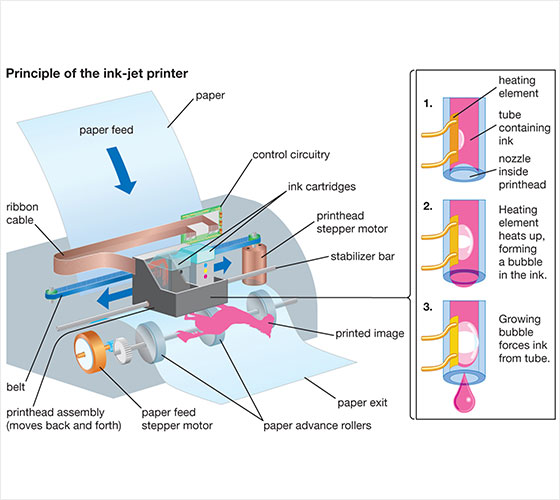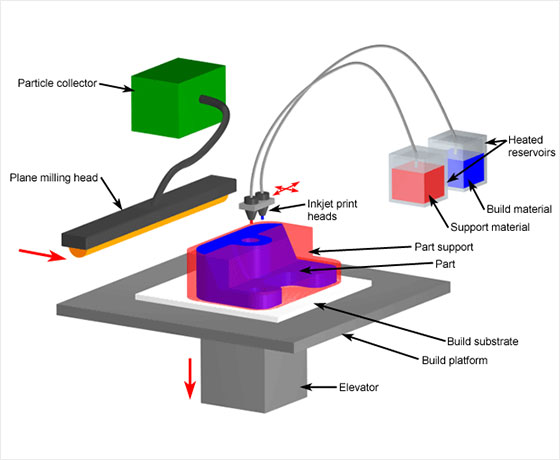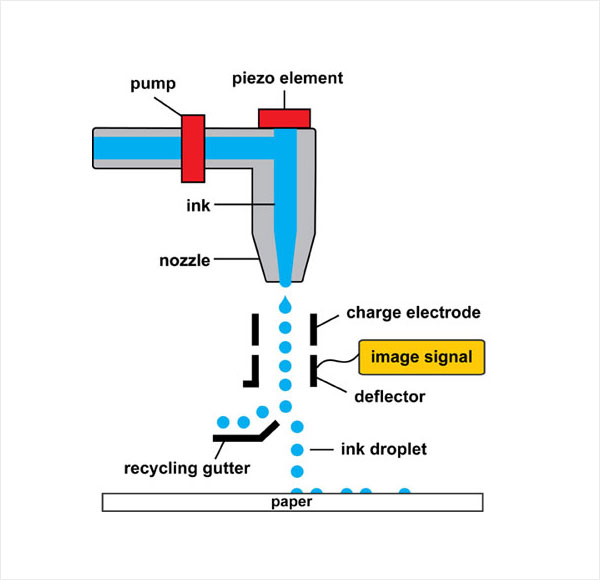Processes
- Polymer Processing
- Injection Molding Insert Molding Blow Molding Over Molding Metal Injection Molding Thermoforming
- Metal Casting
- Die Casting Castings & Forgings Wax Casting Lost Wax Casting Grey Iron Castings Centrifugal Casting Investment Casting Permanent Mold Sand Casting Shell Mold Casting Aluminum Investment Casting Brass Investment Casting Steel Investment Castings Titanium Investment Casting
- Machining
- Milling Turning EDM machining CNC Engraving Hole-making Tap Size Chart Drill Size Chart 5 axis machining Micro Machining CNC Cutting Metal Processes Ceramic Manufacturing Swiss Precision Machining
Materials
Inkjet Printing – What Is Inkjet Printing?
Micron-sized droplets of ink are sprayed onto the paper by an inkjet printer. These droplets mix to produce the desired print. These droplets have a diameter of about 50 to 60 microns. Rather than contacting the paper, the printers spray the dots on it and print out the desired pattern and template. Inkjet printers are gaining popularity these days owing to their dependability and low cost. An inkjet printer is any printer that prints /images by depositing very tiny droplets of ink onto paper. If you’ve ever examined a sheet of paper that came from an inkjet printer, you’re aware of: The dots are very tiny (about 50–60 microns in diameter), even smaller than the diameter of a human hair (70 microns). With a resolution of up to 1440×720 dots per inch, the dots are positioned very accurately (dpi). Different colored dots may be joined to produce pictures of photographic quality.
What Are The Primary Components Of An Inkjet Printer?
A typical inkjet printer is composed of the following components:
- Belt – The print head is connected to the stepper motor via a belt.
- Power supply – A contemporary inkjet printer has an integrated power supply.
- Paper tray/feeder – The printer will have either a tray or a feeder for the papers.
- Rollers – The rollers in the print head assembly draw the paper in from the tray or feeder.
- Control circuitry -The control circuitry decodes the data supplied from the computer to the printer.
- Stepper motor – This motor assists in moving the ink cartridge and printhead back and forth across the paper.
- Interface ports – The inkjet printer communicates with the computer through wires connected via the USB connection.
- Print head – The print head is a critical component of an inkjet printer since it includes nozzles for spraying ink droplets onto the paper.
- Stabilizer bar – The inkjet printer has a stabilizer bar to guarantee the printhead assembly is priced correctly and moves in a regulated manner.
- Ink cartridge – Ink cartridges Each printer type utilizes a unique mix of ink cartridges. They contain a cartridge for each ink color, as well as separate black and color cartridges.

The Inkjet Printing Process – How does the Print head Work?
Inkjet printers deposit microscopic ink droplets onto the paper, where a large number of them combine to form the desired text and picture. You may alter the size and color of the droplets to create pictures that are crisp and photo-realistic. You may determine the printer’s resolution by looking at the dots per inch (DPI). The DPI value indicates the number of tiny droplets that can fit on a single inch of paper. When the DPI setting is increased, the printer produces smaller dots and a clearer picture.
The print head is the most critical component of an inkjet printer since it sprays the ink onto the paper. It is fitted with an array of closely spaced tiny nozzles to guarantee that the ink is sprayed onto a variety of media, including canvas, paper, and cloth. How ink is sprayed onto paper is determined by the underlying technology. Three distinct technologies are utilized to spray ink: Piezoelectric Technology, Thermal Bubble Technology, and Continuous Inkjet Technology are all examples of these technologies.
Pigments, solvents, resins, waxes, varnish, and lubricants are used to create printer ink. Cartridges are used to store the ink. Diverse printer models include a variety of ink cartridges. Pigment-based inks, solvent-based inks, ultraviolet (UV) inks, and dye-based inks are all available for use in inkjet printers.

What Makes Inkjet Printing Unique?
Inkjet printers evolved from dot-matrix printers. Rather of using metal needles, they use hundreds of tiny cannons that shoot dots of ink at the paper. The characters they print are still composed of dots, exactly like those produced by a dot-matrix printer, but the dots are so small that they are invisible. Different kinds of inkjet printers use a variety of different methods to shoot the ink. In Canon printers, ink is discharged by heating it to the point where it bursts in bubbles toward the paper. This is why Canon markets their printers as “Bubble Jet.” Epson printers operate on a somewhat different principle. They take advantage of a phenomenon known as piezoelectricity. Tiny electric currents regulated by electrical circuitry inside the printer cause tiny crystals to bounce back and forth, ejecting ink in jets. Consider inkjet printers as a firing squad of nozzles squeezing millions of dots of ink onto the paper every second!
Advantages Of The Inkjet Printing
Most people are utilizing inkjet printers for several reasons:
- A few printers can also print in photorealistic colors.
- Thanks to the high printhead resolution of inkjet printers, you can enjoy higher-quality prints.
- Printing with jet ink is popular since it dries fast and can be grabbed without smudging the sheet.
- Quiet Operation Inkjet printers are quieter to operate than dot matrix printers and Daisy wheel printers.
- Inkjet printers have lower costs per page than sublimation printers, thermal wax printers, and laser printers, which require warm-up time.
